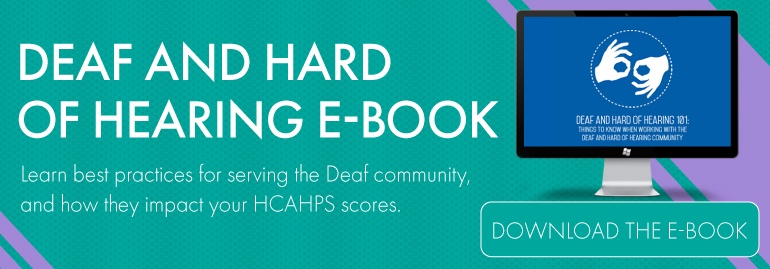
Approximately one million people in the US are functionally deaf, and 6 million people report that they are hard of hearing. How they prefer to communicate depends on their education, the age they became Deaf, and the severity of their deafness.
We’ll cover some of the ways the DHOH would prefer to use to communicate:
American Sign Language Interpreters
For many Deaf people, English is their second language, and many require an interpreter to help them communicate. American Sign Language (ASL) is the official language of the Deaf and Hard of Hearing Community in the United States, and all interpreters for the community are trained in it. ASL has its own grammar and syntax, like any verbal language.
With CyraCom, you can access ASL interpreters via video interpretation. CyraCom’s ASL interpreters are compliant with the ADA and Section 504 of the Rehabilitation Act and maintain certification through the Registry of Interpreters for the Deaf (RID) or the Board for Evaluation of Interpreters (BEI).
Certified Deaf Interpreters
Certified Deaf Interpreters (CDIs) are interpreters who, while being deaf themselves, have been trained to interpret for deaf patients who may have a limited knowledge of American Sign Language (ASL).
“Home signs” are signs that have been invented within a household in order to help with deaf communication between hearing and deaf family members. This occurs frequently in hearing families that have one deaf child, since unfortunately many hearing families never learn ASL. As a result, home signs will differ from family to family. These signs are often incomprehensible to those who understand ASL.
If a patient is not fluent in ASL and uses a mixture of gesture/home signs or have a psychological or physical challenge preventing them from using ASL, a CDI would work with an ASL interpreter to facilitate communication between the Deaf patient and the hearing individual.
Other Ways (That May Not Work)
Lip Reading
A study of 112 individuals with early-onset hearing loss found that participants could lip read an average of 43% of words correctly; out of a sentence of ten words, a deaf individual may only pick up about four by lip reading.
Speaking slowly or loudly
Speaking slowly or loudly is considered offensive to a Deaf person, as it seems condescending. Refrain from speaking slowly or loudly unless a Deaf or HOH person asks you to.
Writing back and forth in English
While providers may feel more comfortable communicating by writing in English, this can come with pitfalls of misunderstanding, especially if English is not the Deaf person’s first language. ASL grammar is very different from English grammar, so writing back and forth may cause misunderstandings. For example, a Deaf person whose native language is ASL may write, “I sick know nothing happen last week hit,” which translates to “Doctor, I’m sick, I’m not sure what’s going on. It started last week.” Someone unfamiliar with ASL may instead interpret it to mean, “I’m sick. I know nothing happened. Last week I was hit.”
If You’re Not Sure, Ask!
Don’t be afraid to ask them how they would prefer to communicate if the method you first provide does not seem to suit them. Not all Deaf people communicate in ASL; estimates of ASL users vary from 100,000 to 2 million in the United States, and many adults (over half of those who report being functionally deaf or hard of hearing) who become deaf late in life and never learn ASL.
For more information about the Deaf and Hard of Hearing Community, please see our whitepaper.




